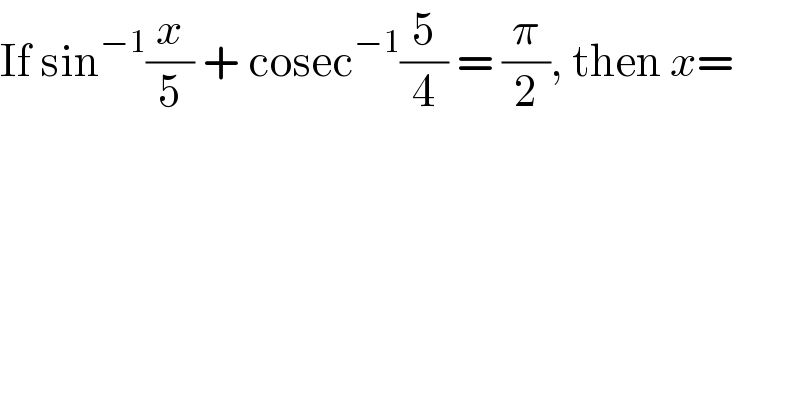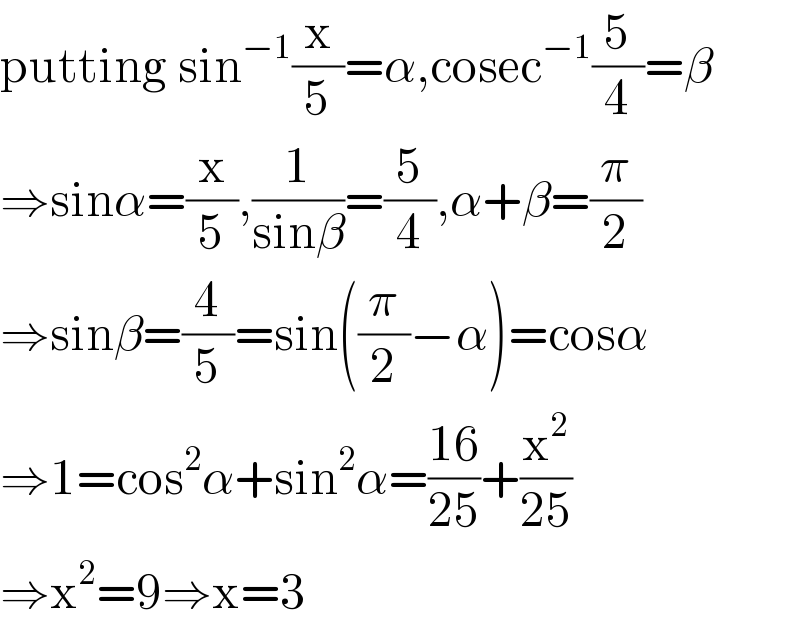Question Number 96845 by DELETED last updated on 05/Jun/20

$$\mathrm{If}\:\mathrm{sin}^{−\mathrm{1}} \frac{{x}}{\mathrm{5}}\:+\:\mathrm{cosec}^{−\mathrm{1}} \frac{\mathrm{5}}{\mathrm{4}}\:=\:\frac{\pi}{\mathrm{2}},\:\mathrm{then}\:{x}= \\ $$
Answered by Sourav mridha last updated on 05/Jun/20

$$\Rightarrow\mathrm{sin}^{−\mathrm{1}} \left(\frac{\boldsymbol{{x}}}{\mathrm{5}}\right)=\mathrm{cos}^{−\mathrm{1}} \left(\frac{\mathrm{4}}{\mathrm{5}}\right)=\mathrm{sin}^{−\mathrm{1}} \frac{\mathrm{3}}{\mathrm{5}} \\ $$$$\Rightarrow\boldsymbol{{x}}=\mathrm{3} \\ $$
Answered by 1549442205 last updated on 05/Jun/20

$$\mathrm{putting}\:\mathrm{sin}^{−\mathrm{1}} \frac{\mathrm{x}}{\mathrm{5}}=\alpha,\mathrm{cosec}^{−\mathrm{1}} \frac{\mathrm{5}}{\mathrm{4}}=\beta \\ $$$$\Rightarrow\mathrm{sin}\alpha=\frac{\mathrm{x}}{\mathrm{5}},\frac{\mathrm{1}}{\mathrm{sin}\beta}=\frac{\mathrm{5}}{\mathrm{4}},\alpha+\beta=\frac{\pi}{\mathrm{2}} \\ $$$$\Rightarrow\mathrm{sin}\beta=\frac{\mathrm{4}}{\mathrm{5}}=\mathrm{sin}\left(\frac{\pi}{\mathrm{2}}−\alpha\right)=\mathrm{cos}\alpha \\ $$$$\Rightarrow\mathrm{1}=\mathrm{cos}^{\mathrm{2}} \alpha+\mathrm{sin}^{\mathrm{2}} \alpha=\frac{\mathrm{16}}{\mathrm{25}}+\frac{\mathrm{x}^{\mathrm{2}} }{\mathrm{25}} \\ $$$$\Rightarrow\mathrm{x}^{\mathrm{2}} =\mathrm{9}\Rightarrow\mathrm{x}=\mathrm{3} \\ $$
